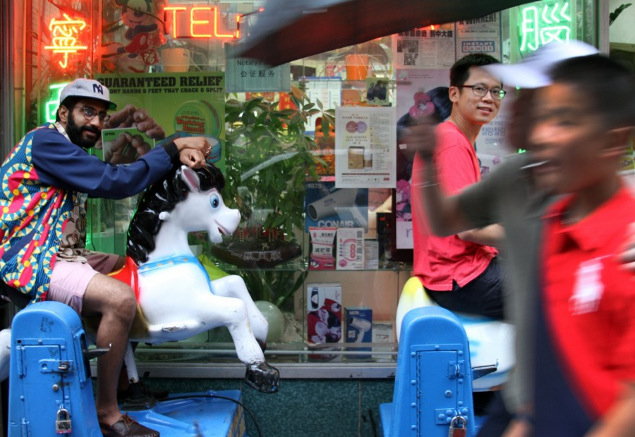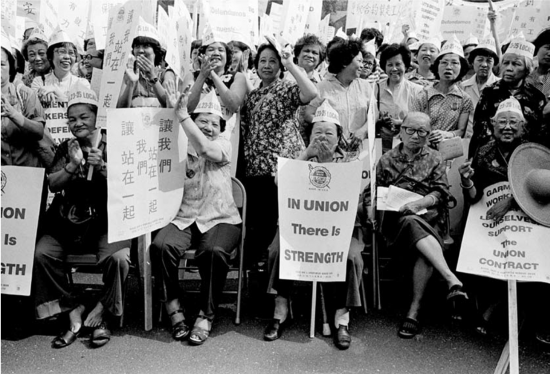For the women who dance together at a Chinatown park, every gesture brings them closer together and every step leads them away from the dangers of depression.
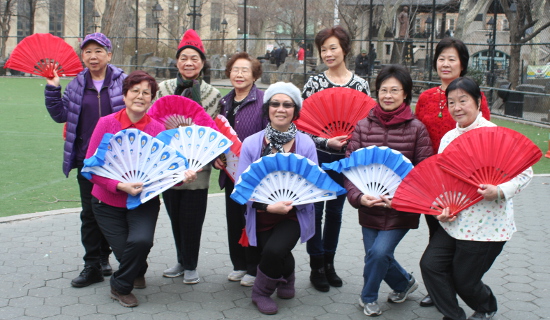
April 5, 2016
In the shadow of the Chatham Towers apartment complex in Manhattan’s Columbus Park on an early February morning, a group of Asian women with outstretched hands and jutted out legs danced in synchrony to music on someone’s borrowed boom box. Walking along the wide perimeter of the basketball court, the sounds of the music begins to sound methodical.
“Left, left. Right, right. Go tether bound. Go. Go. Go,” a pleasant female voice on the boom box encouraged a dancing group of 14 women. This group of women was practicing Guang Chang Wu, a form of square-dancing so popular among millions of older Asian adults that the Chinese government issued standards and regulations for the exercise last year.
On a weekly basis, many of the women converge at this park to free themselves from their daily concerns about aging family members, finances, and even their occupations. They’re also there because this may be the only time they have companionship all week.
The women also come together to dance because otherwise, their alternative may be to go see a therapist – a largely undisclosed practice within many Asian communities, which still equate seeing a therapist with being mentally imbalanced.
To avoid seeing mental health specialists and escape the stigma associated with being mentally imbalanced, many turn to exercise and dance that have been proven to lower stress and alleviate symptoms of depression.
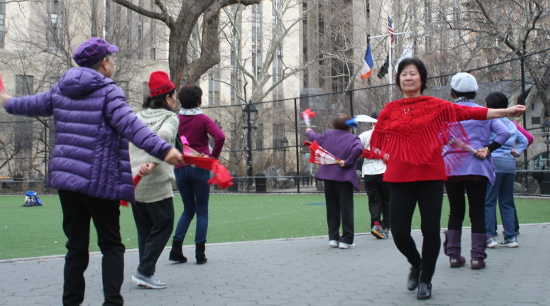
Wendy Sui, who came to the country in 1971, has been dancing for over a decade. She only comes only during the weekends since it takes her an hour to travel on the bus from New Jersey. But it’s worth it for her.
“I was a seamstress – and later an accountant — working day and night and I just needed to get out of that environment,” Sui said. “Chinatown is a familiar sight to me and I began to do this activity because it made me feel closer to people.”
It’s 45 degrees out at 7:45 a.m. and some women are in winter gear. They take a break for a minute or two between each song, ladies pairing off to quickly gossip or to shed vests and hats. For an hour and a half, the women are dancing in rows of three. They’ll later leave for a nearby tea shop to chat about their week.
As they gracefully moved to the beat of the music, instructor Alice Shu took to the front of the group facing the playground. She casually glanced back to help the less coordinated individuals who missed a beat or failed to kick up their right legs in time with the music.
“A U.S. Census Bureau report bears out this fact –Asian Americans have the highest rates of limited English proficiency in the country at 35 percent. “
None of the ladies needed help, though. After all, the exercise steps took about one to two weeks to learn and this core group of women has been doing Guang Chang Wu for decades.
Shu, originally from Hong Kong, has been in the United States for nearly 30 years. She first arrived in Minnesota, but later moved to New York’s Chinatown to be closer to other ethnically Chinese people. She has since been teaching Guang Chang Wu for more than a decade in Chinatown, explaining that the activity has helped her maintain her “good health” over the years.
Guang Chang Wu, a form of public square dancing popular in China because it’s relatively low-cost and doesn’t require provocative or extraneous outfits, has been touted by the Chinese for its benefits for the body. Instructors teach about the qi body technique, allowing people to stretch their bodies and necks. In China, many participants take part because of the social aspect that allows them to spend time with their friends.
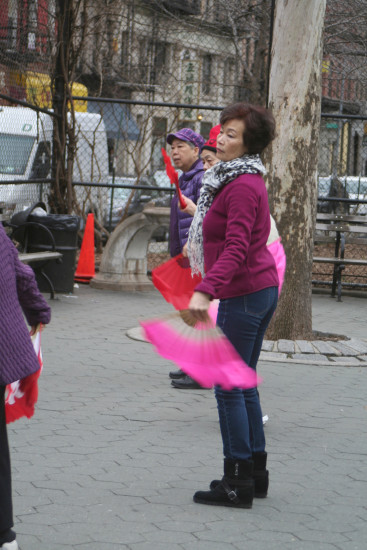
“We have a group of friends who want to come out every morning to walk around and do the exercise,” Shu said.
Though most of the women have limited English proficiency and may not even speak the same dialect, Guang Chang Wu has helped this group maintain friendships that they otherwise would not have the opportunity to make during their retirement years. “First of all, most of [these ladies] are semi-retired. I’m going to be retired soon, so we just want to meet to make more friends and exercise together to bring good health,” Shu explained.
Forty yards away, another group of nine women were dancing to Yuan Ji Wu, a related form of exercise that blends martial arts techniques with dance and Qi Gong, an ancient holistic approach to coordinating body posture, breathing, and meditation.
When this group of women saw a photojournalist, they excitedly crowded around a bench, handing out traditional Chinese folding fans. Then, they fell back into formation. Even in track suits, the women moved with the graceful elegance of dancers who are decades younger. Many of these women are already in retirement, with a few more in their late 70s. One woman is 81.
Similar to Guang Chang Wu, Yuan Ji Wu is a form of exercise that helps women to remain healthy in their sunset years. The exercise doesn’t require women to be incredibly active, so there isn’t much strain on the knees. The activity is popular among Taiwanese women and has also been imported to the United States, with a heavy presence on the West Coast. The effects of Yuan Ji Wu are pretty apparent – a 2010 Journal of Sports Science and Medicine study said that Yuan Ji Wu dancers have greater balance and reaction time.
A Myanmar immigrant who would only give her name as Ms. Mee said that she’s been doing Yuan Ji Wu for 17 years. “I do this to befriend people from other countries,” she said. “I’m from Myanmar and I love it here because there are so many Asian people. [This group] get[s] along really well.”
“U.S. Chinese women have the highest rate of completed suicides over any other racial groups. Elderly Chinese women fall on the higher end of that spectrum.”
The women are just a couple of examples of the Dancing Grannies of Chinatown — ages ranging between 50 and early 80s — who use exercise to work on a holistic approach to mental, spiritual, and physical well-being. Though these women are generally respectful of the noise level, other such “Dancing Grannies” have been called public nuisances.
In China, massive crowds of women usually begin dancing early in the morning to loud music. Many congested cities in China do not have much open spaces and parks, and Guang Chang Wu, in particular, takes up a lot of space. This led to many of these dancing sessions taking place near residential spaces, drawing the ire of residents living around these areas.
As a result of the deluge of complaints against the noise levels, Beijing was forced to issue national standards and regulations, including a list of 12 approved dances. Some residents took matters in their own hands; there have been reports of dancers at the receiving end of garbage and even excrement hurled by irate residents.
In one local case, an instructor was arrested in Brooklyn’s Sunset Park after her group of dancers enraged locals.
Still, that cannot take away the benefits that the dances bring to those who participate in them. They could help break down language barriers. Though both groups of women spoke Mandarin Chinese with strict efficiency, many do not speak English well, a factor that could isolate them from the larger American society.
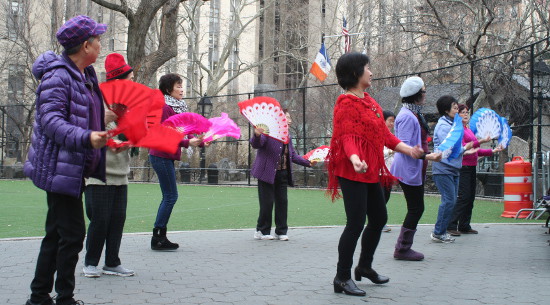
A U.S. Census Bureau report bears out this fact –Asian Americans have the highest rates of limited English proficiency in the country at 35 percent. Though the women didn’t indicate that dance united them as though it was a common language, they did fall into natural rhythm and laughter.
But it’s the mental health benefits of these exercises that are especially notable, given that these women come from a culture where they feel stigmatized if and when they seek out therapists for their anxiety or depression issues. It’s an unspoken rule among Asians that only “crazy people” have mental health issues.
It’s perhaps unsurprising that the kind of shame associated with seeing a mental health specialist correlates with higher suicides among elderly Chinese, which a 2015 Aging and Disease study said, “constitute one-fifth of all recorded suicides in the world,”
In particular, U.S. Chinese women have the highest rate of completed suicides over any other racial groups. Elderly Chinese women fall on the higher end of that spectrum.
“[Dancing] is an activity that gathers a group of people — who I didn’t have to be lifetime friends with,” Sui from New Jersey explained. “But it feels nice for the social interaction because then I would feel less lonely.”
That’s why dancing could have such a profound impact on reversing the trend by providing a consistent source for friendship and exercise. And these women are proof that dancing can impart a lasting effect on good mental health.
“”We’re like sisters,” said Pam, a retired teacher who requested for her last name to be withheld and who has lived in the country for 40 years. “We invite everyone for coffee.”
This story is part of an ongoing series featuring #ChinatownArts, made possible through the generous support of City Council Member Margaret Chin.

